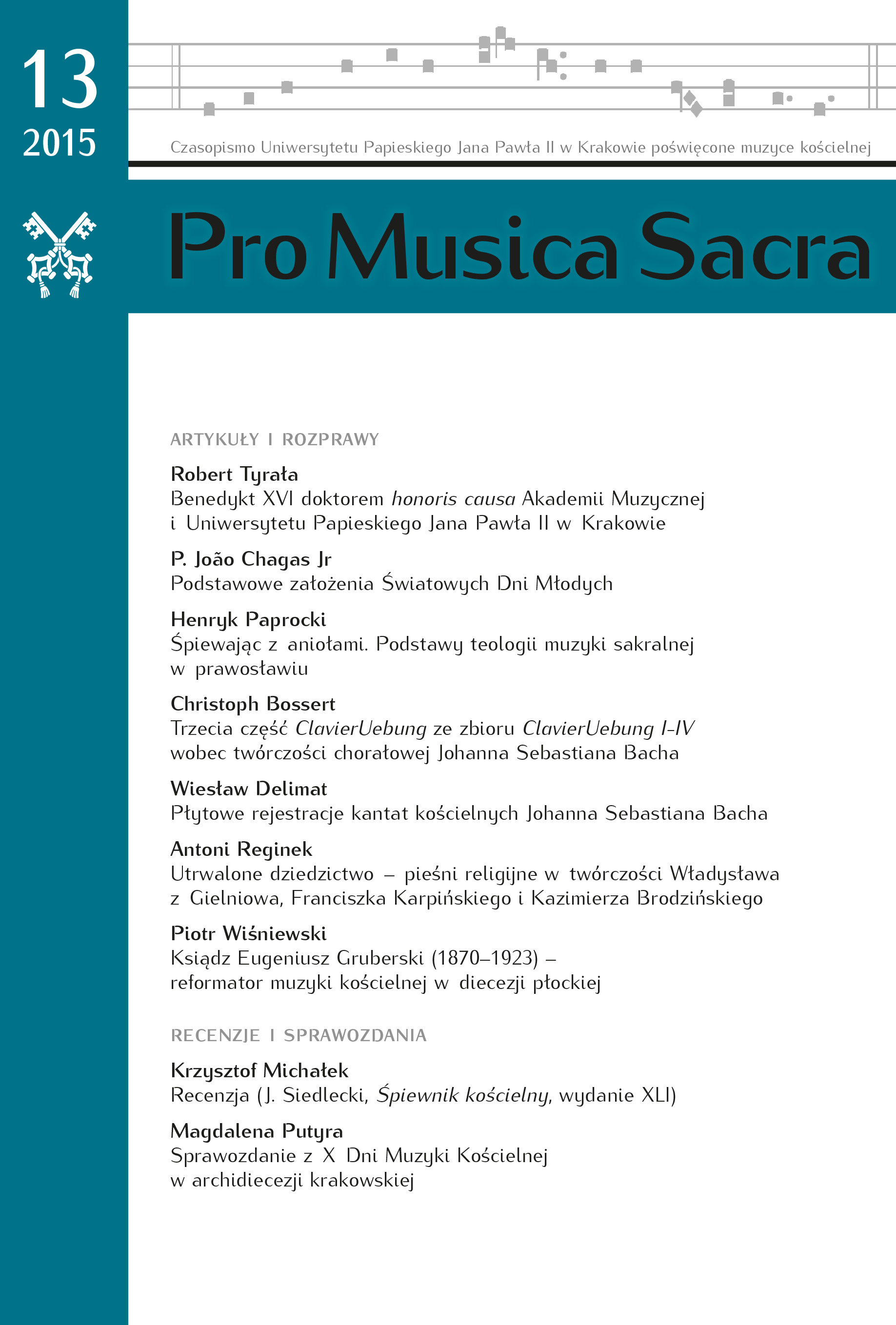Śpiewając z aniołami. Podstawy teologii muzyki sakralnej w prawosławiu
DOI:
https://doi.org/10.15633/pms.1115Słowa kluczowe:
muzyka sakralna, liturgia, prawosławie, estetykaAbstrakt
Rozważania na temat teologii muzyki sakralnej w prawosławiu autor zaczyna od przypomnienia faktu, że cała liturgia jest precyzyjnie opisana w księdze zwanej Typikon, która jest zarazem scenariuszem i partyturą nabożeństwa. Typikon wprowadza uporządkowanie w żywioł modlitwy, równocześnie kładąc nacisk na piękno. Dlatego też takie pojęcia, jak artyzm, artysta, sztuka, twórczość, zajmują ważne miejsce w myśli Ojców Kościoła. Istota tej muzyki sprowadza się do nieustannego dążenia do niebiańskiego archetypu celem osiągnięcia jedności świata Boskiego i świata ludzi. Muzyka liturgiczna jest więc jednym ze sposobów przezwyciężenia stanu upadku i przywracania utraconej jedności. Teoria śpiewu cerkiewnego zrodziła się w Bizancjum i oddziałała na ukształtowanie się bizantyjskiego wzorca muzycznego, który tak zachwycił posłów księcia Włodzimierza w Konstantynopolu. Piękno liturgii greckiej stało się jednym z kryteriów prawdziwości wiary. Zachwyt wobec piękna liturgii nie jest estetyczną oceną, ale chęcią osiągnięcia istoty Boga poprzez piękno. Na koncepcję bizantyjską ogromny wpływ wywarła idea wzorca Boskiego, który został przekazany ludziom od Boga przez aniołów lub świętych. Ta zasada odnosiła się do wszystkich rodzajów sztuki, w tym także muzyki. Zgodnie z tradycją znany bizantyjski hymnograf, poeta i muzyk św. Roman Melodos otrzymał w sennej wizji dar układania kontakionów i śpiewania. W świątyni objawiła mu się Bogurodzica, dała zwój i poleciła go spożyć. Po przebudzeniu się Roman Melodos zaśpiewał „Dziewica dziś rodzi”. Dlatego też jego twórczość jest owocem daru otrzymanego od Boga. Z kolei porównanie śpiewu cerkiewnego z niebieskim (od VIII wieku chóru) znalazło swój wyraz w hymnach liturgicznych, które mówią, że ludzkie głosy mieszają się ze śpiewem cherubinów, tworząc chór głoszący chwałę Boga jako „ikona w dźwiękach”. Śpiew liturgiczny przeciwstawia się śpiewowi ludowemu, folklorowi. Śpiewacy cerkiewni przedstawiali aniołów i dlatego sama nazwa „chór” nawiązuje do koncepcji dziewięciu chórów anielskich. Śpiew liturgiczny powinien brzmieć podniośle, niebiańsko, powinien być zdematerializowany (czemu sprzyjała architektura cerkwi, dająca efekt lotu dźwięków zlewających się w kopule i powracających stamtąd jak nieziemski, niebiański śpiew).
Bibliografia
Arranz M., Istorija tipikona. Opyt, Leningrad 1978.
Egeria, Pielgrzymka do miejsc świętych, przekł. W. Szołdrski, Warszawa 1970.
Florenski P., Świątynia jako synteza sztuk, [w:] P. Florenski, Ikonostas i inne szkice, przekł. Z. Podgórzec, Białystok 1997, s. 33–47.
Florenski P., Liturgia jako synteza sztuk, [w:] P. Florenski, Ikonostas i inne szkice, przekł. Z. Podgórzec, Białystok 1997, s. 35–38.
Heger P., The Development of Incense Cult in Israel, Berlin–New York 1997.
Jeanin J., Puyade A., L’Octoechos syrien. Etude historique, „Oriens Christianus” 13 (1913), z. 3, s. 87–89.
Kovalevsky M., Chant liturgique, icône sonore, [w:] Nicée II. 787–1987. Douze siècles d’images religieuses, Paris 1987, s. 225–237.
Kovalevsky M., Le Rôle du choeur dans la liturgie chrétienne, [w:] L’Assemblée liturgiques et les differents rôles dans l’assemblée, Roma 1977, s. 225–307.
Lidow A., Sozdanije sakralnych prostranstw kak wid tworczestwa i priedmiet istoriczeskogo issledowanija, [w:] Ijerotopija. Issledowanije sakralnych prostranstw, Moskwa 2004, s. 17–21.
Paprocki H., Ikona jako twórcze przezwyciężenie zła, „Wiadomości Polskiego Autokefalicznego Kościoła Prawosławnego” 15 (1985), z. 1–4, s. 40–50.
Paprocki H., Liturgia i estetyka, „Wiadomości Polskiego Autokefalicznego Kościoła Prawosławnego” 20 (1990), z. 77, s. 22–30.
Paprocki H., Teologia muzyki sakralnej, [w:] Chrześcijańskie dziedzictwo duchowe narodów słowiańskich, pod red. Z. Abramowicz, Białystok 2003, s. 33–36.
Schmemann A., Introduction to Liturgical Theology, London 1966 (Wwiedenije w liturgiczeskoje bogosłowije, Paris 1961).
Schmemann A., Aspects historiques du culte orthodoxe, „Irenikon” 46 (1973), z. 1, s. 5–15.
Taft R., The Liturgy of the Hours in the Christian East, Karikkamuri 1984.
Taft R., The Liturgy of the Hours in East and West, Collegewille (MN) 1986.
Tïpikon, si’est oustaw, Moskwa 1854 [reprint: Graz 1964].
Trubaczow S., Muzykalnyj mir P. A. Florenskogo, „Sowietskaja Mjuzika” 1988, z. 9, s. 99–103.
Trubieckoj J., Kolorowa kontemplacja. Trzy szkice o ikonie ruskiej, przekł. H. Paprocki, Białystok 1998.
Władyszewskaja T., Bogoduchnowiennoje angiełogłasnoje pienije w sistiemie sriedniewiekowoj muzykalnoj kultury (Ewolucija idiei), „Slavia Orientalis” 38 (1989), s. 351–369.
Władyszewskaja T., Muzyka driewniej Rusi, [w:] G. Wagner, T. Władyszewska, Iskusstwo driewniej Rusi, Moskwa 1903, s. 172–182.
Władyszewskaja T., Zarożdienije russkoj cerkownoj muzyki i jeje estietika, „Cerkownyj Wiestnik” 36 (1989), z. 10–12, s. 51–66.
Pobrania
Opublikowane
Numer
Dział
Licencja
Autorzy publikujący w czasopiśmie udzielają jego wydawcy zgody o następującej treści:
- Autor zachowuje autorskie prawa majątkowe do utworu, a jednocześnie udziela wydawcy czasopisma zgody na jego pierwszą publikację w wersji drukowanej i wersji online na licencji Creative Commons Uznanie autorstwa 4.0 Międzynarodowe oraz zgody na wykonywanie opracowań, w tym przekładów.
- Autor ma możliwość udzielania zgody niewyłącznej na opublikowanie utworu w wersji, która ukazała się w czasopiśmie (np. zamieszczenia go w repozytorium instytucjonalnym lub opublikowania w książce), wraz z informacją o jego pierwszej publikacji w czasopiśmie.
- Autor może umieścić swój utwór online (np. w repozytorium instytucjonalnym lub na swojej stronie internetowej) jeszcze przed zgłoszeniem utworu do czasopisma.

